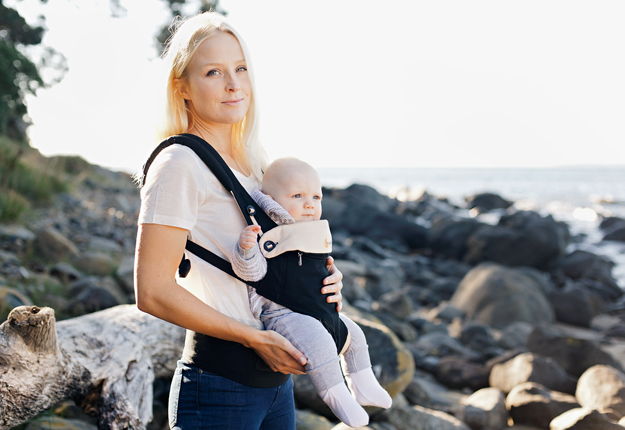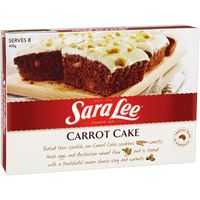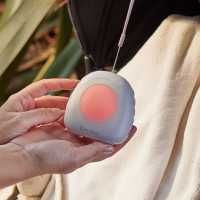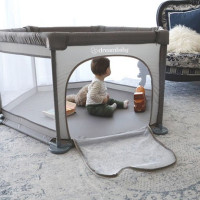For mums, postural overload is often an issue as her shoulders become rounded and her upper back stiffens from scooping up and nursing her newborn up to 50 times a day.
Add bigger breasts, the loss of abdominal support, a changed centre of gravity and the tendency to carrying bub in front of the body to the mix, and you have a recipe for back pain.
Make time for yourself
Factoring in a little time to strengthen, lengthen and support your body can save you the months of pain and rehabilitation that often accompanies a back injury.
Make sure you look after yourself by:
- Doing gentle exercises to support your back
- Increasing stretching to keep tight muscles at bay
- Accessing care from chiropractors, physiotherapists and massage therapists to support you during this important stage
- Choosing the right carrier
More on carriers
A well-fitted structured or soft carrier is a great investment in your spinal health.
Look for wide waistbands so your hips can carry the majority of the weight, rather than putting strain on your back. Thick shoulder straps are also ideal to evenly distribute bub’s weight. Avoid bands that cross at in the ‘bra strap’ zone of the back, as this area is often already stiff and the addition of the strap can make the problem worse.
A good carrier is better for your baby’s growing body, too. It’s ideal for him to be in the frog leg position to protect his legs and hips until he can weight bear. Avoid carriers that leave his legs dangling straight as it increases the pressure on his sacrum and stretches the ligaments of his developing hip joints.
Lifting
- Hip Hinge
Pregnancy and birth play havoc with your abdominal muscles and the weakness that it causes means your lower back can easily become overloaded.
When you bend forward from the lower back, the natural curves in your spine don’t work properly and can’t evenly distribute weight throughout all the spinal joints. This leaves all the weight focused on a few lower back joints and, if you’re then lifting on top of this, you will place torsion stress on the lower back discs. Repeating this type of unsafe lifting every day will cause degenerative changes to the spine and discs over time. Learning to bend forward (hinge) from the hip joints, rather than the lower back, will decrease the repetitive forces you place on the discs and ligaments, and preserve your ongoing spinal health.
- Golfer’s Lift
This is another safe way to bend if you’re picking up toys and other small items from the ground. To do a golfer’s lift, position yourself as close to the object you’re picking up as you can, then lift one leg straight out behind you for balance while also keeping your back straight. Support your spine by lightly sucking in your belly button to activate your core muscles.

Supported sleep
Getting enough sleep is critical to your health, but it’s generally pretty tough to convince your baby of its importance. To ensure that whatever sleep you do get is as restful as possible, here are a few things you should consider to support your body during sleep:
Choose the right pillow: Have you ever woken up with a sore neck? A comfortable, supportive pillow is essential for a good night’s sleep. Contoured pillows that are tailored to your body type are best because they support the natural curve of your spine and take the stress off your neck and upper back musculature.
Relax your spine: Use a rolled towel under your lower back or neck to improve your spinal curves. Take deep belly breaths and put one hand on your heart and one hand on your belly (focus on the belly moving) for 3-5 minutes to unwind. This will help your posture and the quality of your sleep.
Back sleepers: Your pillow shouldn’t be too large because it will bend your neck forward. Also place a pillow under your knees to reduce stress on lower back.
Side sleepers: Your pillow should be as thick at the gap between the tip of your shoulder and the side of your neck to hold your spine in a neutral position. Place a pillow between your legs to keep your hips level and prevent you rolling into a twisted position.
Tummy sleepers: You should avoid sleeping in this position as it places a lot of stress on your neck. If you must sleep this way, place a pillow under your stomach instead of under your neck.
Body Pillows: These mattress-sized pillows are designed to cradle the body to take pressure off your pelvis and lower back. If you sleep on your side, you can place the pillow in between your knees or, if you sleep on your back, you can place it underneath them. They’re a good option if you suffer from joint and muscle pain as your body is kept in alignment to eliminate any strain.
Share the love
There is a lot to think about when you bring your new baby home and it’s easy to put your own health and wellbeing to the side as you immerse yourself in motherhood. It’s important to remember though that your body needs time to recover from pregnancy and birth so share the love and nurture yourself as well as your new addition. Being a mum is most enjoyable when you’re feeling rested, strong and pain free.
What do you look for in a good baby carrier?
Share your comments below.
Dr. Kelly Ryan is a chiropractor with a special interest in pregnancy care. She helps women have a pain free pregnancy and the best chance at their planned birth experience. She also works with new mums to maintain their spinal health and support their baby’s growth in their vital first years of development.
When you need a doctor urgently but your GP is closed, call 13SICK for a bulk billed, after hours, doctor home visit.

Read more from The National Home Doctor Service:
We may get commissions for purchases made using links in this post. Learn more.




















-

-
-
-
mom94125 said
- 06 Oct 2017
Reply
-

-
-
-
natct said
- 20 Jul 2017
Reply
-

-
-
-
june11 said
- 10 Jul 2017
Reply
-

-
-
-
mom183717 said
- 24 Jun 2017
Reply
-

-
-
-
Ellen said
- 20 Jun 2017

Reply
-

-
-
-
curlytops said
- 20 Jun 2017
Reply
-

-
-
-
mom206279 said
- 19 Jun 2017
Reply
-

-
-
-
BellaB said
- 19 Jun 2017
Reply
-

-
-
-
mom160421 said
- 19 Jun 2017
Reply
Post a comment12:21 am
9:13 am
8:01 pm
8:09 am
7:57 am
6:49 am
4:09 pm
3:49 pm
2:38 pm